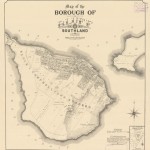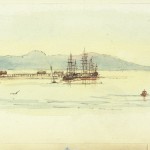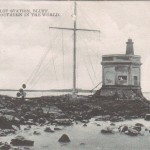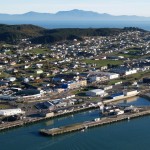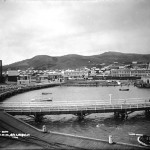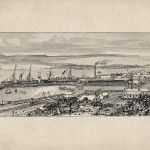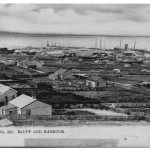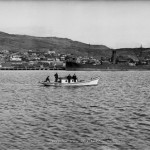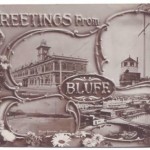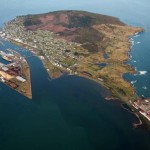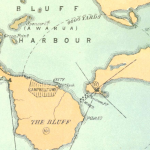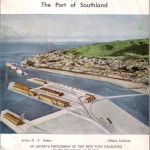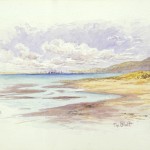Bluff is a port-town located on a peninsula at the southern end of the South Island of New Zealand. Nestled below a prominent 265m conical hill from which the town takes its name, the area has been permanently occupied since the establishment of a shore-whaling station in 1836.
“An Outpost of Maoritanga”
This was how Bluff was described in 1956 and this Māori presence runs deep: place-names and archaeological sites in and around the area indicate that it was explored and utilized by waves of Māori in pre-European times. And, as with other parts of the Foveaux Strait region, Bluff was an important site of cross-cultural encounter in the first half of the nineteenth century. All of this is still evident in the town’s make-up and lifeways. For example, Bluff is the main staging post for the seasonal tītī/muttonbird harvest that takes place on islands clustered around Stewart Island; an activity that many Bluff people take part in. As was noted by the ethnographer Herries Beattie in 1944, “There are probably more residents with Maori blood in Bluff than in any other town in the South Island.”
Colonial Development
In 1856, the port’s settlement was officially named Campbelltown but it continued to be called The Bluff—or simply Bluff—which became its official name in 1917. In 1867, Bluff was connected by railway to the burgeoning settlement of Invercargill, Southland’s commercial centre, thereby securing its status as the southern region’s main port. Bluff enabled and grew off the back of the agricultural development of the Southland plains, especially from the 1880s when frozen meat began to be exported to Britain. A key architect of Bluff’s colonial development was one of its own best sons: the prominent businessman and politician, Sir Joseph Ward (1856-1930), who is New Zealand’s longest serving Cabinet minister. Bluff was also—and remains—home to one of New Zealand’s most important inshore fishing fleets and is where Foveaux Strait’s world-famous oysters are landed.
“Bluff is New Zealand’s equivalent, say, of Steinbeck’s Cannery Row. There were wonderful characters. The language was awful. I’ve never heard such language in all my life.”
“One of the farthest corners of the British Empire”
The inaugural Royal Tour of New Zealand by Queen Elizabeth II and Prince Philip, the Duke of Edinburgh, concluded at Bluff in January 1954. By this time preparations had began for the construction of a large island harbour on top of a sandbank from which the area’s main Māori name is derived: Awarua. Buoyed by post-war prosperity, Bluff’s Island Harbour was opened in 1960. Along with the development of all weather meat loaders, the port’s long-term value and viability was thought to be secure. However, this was not to be. The containerization of cargo from the mid-to-late 1970s and a drastic reduction in the export of primary products to Britain following its orientation towards Europe reduced Bluff’s importance.
Accordingly, from a peak of 3,300 in 1970, the town’s population declined slowly through the 1980s and then markedly following the closure of Bluff’s major employer, the Ocean Beach Freezing Works, in 1991. The population now stands at roughly 1,800, which is about what it was 100 years ago.
“Since the days of the early sealers and whalers, the town of Bluff has developed a character entirely its own – something more distinctive than the features of any other New Zealand seaport town…The people and town of Bluff have had a long and ever-expanding contribution to the rest of New Zealand through the fishing-industry, fish and meat processing, and farming.”
An important locale
Bluff bears hallmarks of trends and events that have shaped much of New Zealand generally. These include a dependence on distant markets and foreign capital. At the same time, the port has some distinctive features as a result of its early maritime connections with New South Wales and its relatively large Māori population. In short, Bluff exposes patterns of connection between land and sea, and Māori and non-Māori, and is therefore an ideal analytical site for historical investigation.
- Map of the Borough of Bluff, Southland, 1951. Sourced from LINZ. Crown Copyright reserved.
- Katherine McLean Holmes, Bluff Harbour, watercolour 1874.
- Photograph of Bluff by Muir and Moodie, Dunedin.
- Walter Deverell, The Bluff. ca 1900. Pen, ink and wash sketch. View from the hills behind Bluff looking north east down towards the factories and wharf area, with houses and a church to the right and Tiwai Point in the background.
- R P Moore, Panoramic view of Bluff, ca 1925-1928. R P Moore Collection, Alexander Turnbull Library.
- God created Bluff because the hardout need a place to live. Chalkboard message in shop window.
- Artist’s impression of Bluff Port, from Whites Aviation. Artist: N.T. Gedye.
- Charles Nathaniel Worsley, The Bluff 1902. Alexander Turnbull Library, Wellington, New Zealand.
